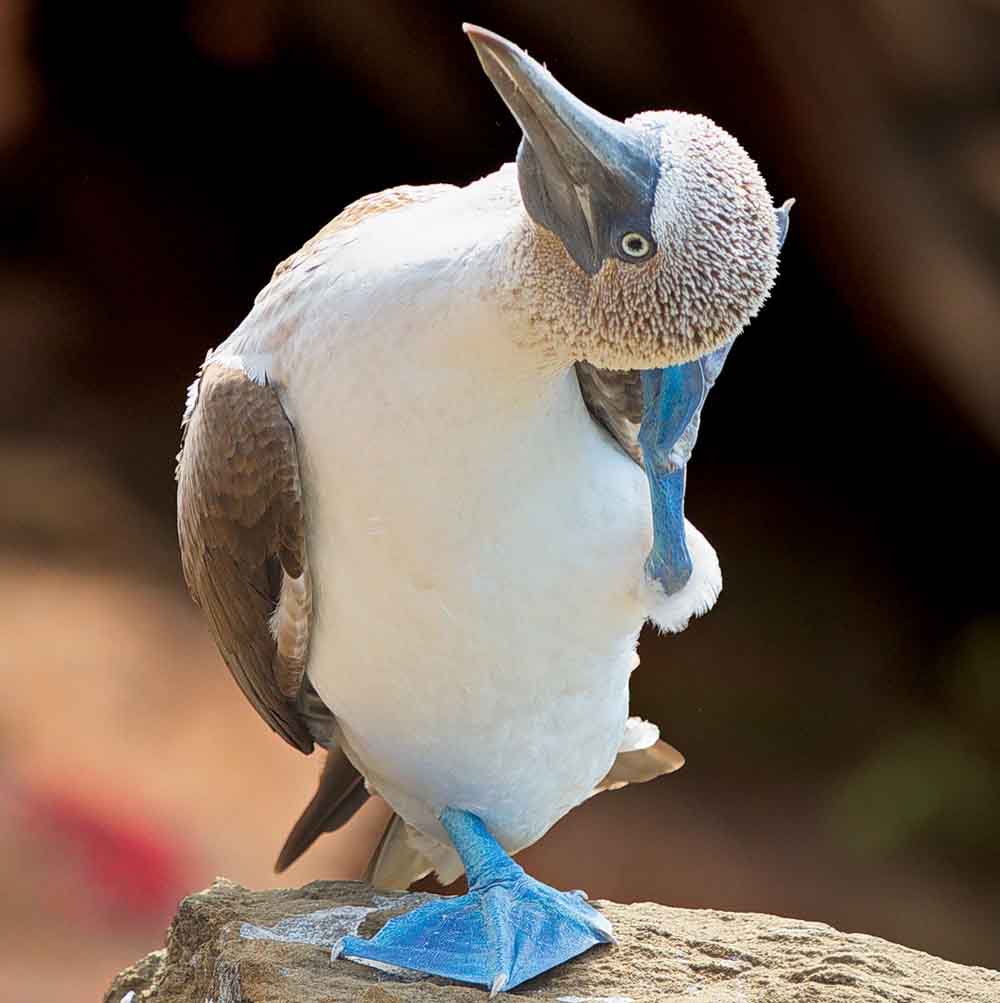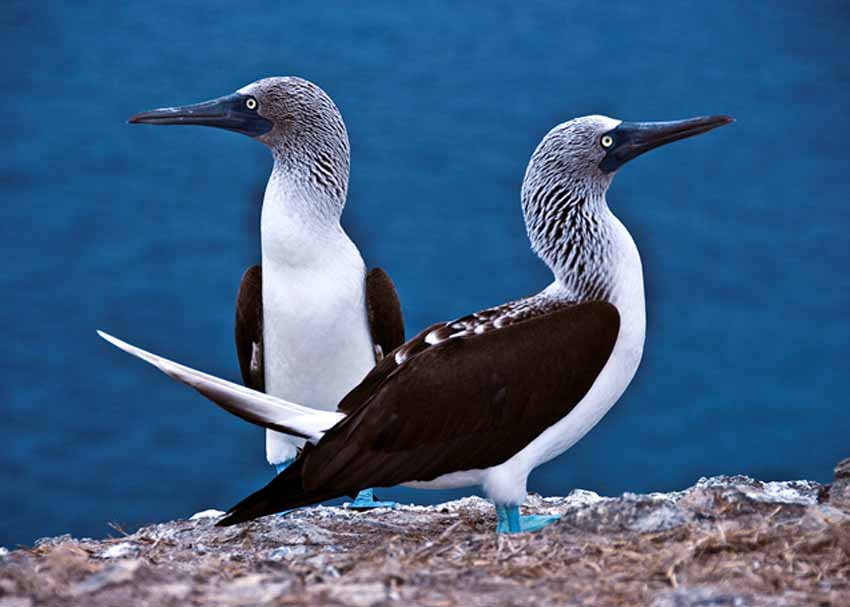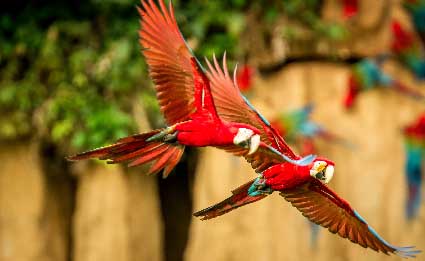
Interested to learn about blue footed boobies? In this post, you’ll learn nine blue footed booby facts.
9 Blue Footed Booby Facts (Galapagos Islands)
Blue footed boobies are some of the most famous avian residents of the Galapagos Islands.
This bird with a pale body, light brown wings, and distinctively sky-hued webbed feet is a fairly small bird that weighs an average of 3.3 pounds (1.5 kg) but can have a wingspan of up to five feet. Here are nine blue footed booby facts that make the bird such a remarkable animal.
1. About half of the world’s blue footed boobies live in the Galapagos Islands
While blue footed boobies don’t live exclusively in the Galapagos, about half of the world’s nesting pairs of these birds make their nests in the Galapagos Islands. The bird can be found all along the Pacific Coast of North America and South America, from California to Peru. More rarely, they can be spotted in Arizona and Texas.
Blue footed boobies are frequently found on the Pacific Ocean’s subtropical and tropical islands, including the Galapagos. Those that live in the Galapagos are considered a subspecies, with the Latin name Sula nebouxii excisa.
In all, there are thought to be about 80,000 blue footed boobies in the world. Their population is considered relatively stable and of the least concern, as far as danger of extinction goes. It’s extremely common for tourists and visitors to the Galapagos to spot these fascinating birds, especially on Daphne, Espanola, Isabela, and San Cristobal Islands.
2. Their name comes from the Spanish word “bobo”
“Bobo” is a Spanish term that means “foolish.” The blue footed boobies are not a particularly foolish bird – birds in general are rather smart creatures – but it does walk rather awkwardly on land.
Blue footed boobies walk around with a sort of wobbling waddle, somewhat like the characteristic shuffle associated with penguins. This probably made the bird look a little foolish or clownish, or at least clumsy, to early explorers. Sula nebouxii’s common name never had anything to do with a part of the mammalian anatomy.
3. Males with the bluest feet have the greatest chances of mating
In blue footed booby society, the bluer your feet are, the more likely it is that a female will find you attractive enough to mate with.
Males appear to be proud of their striking bright blue feet. During mating season, male blue footed boobies do a sort of mating dance in which they prominently display their feet by high-stepping, pointing their beaks toward the sky, bobbing, strutting, stamping their feet, and whistling.

Here are 94 birds to watch for in the Galapagos.
4. They’re related to pelicans
Blue footed boobies are one of six species of boobies. All six species belong to the order Pelecaniformes, the order of birds that also includes pelicans.
5. They make their nests out of dirt and poo
Boobies nest directly on the bare ground, making their nests out of earth. They then cover their nests with a layer of their own droppings, which are known as guano. Baby blue footed boobies are born into these nests and then kept warm by the parents using their big blue feet to cover the nestlings.
Unlike some other bird species, boobies lack a bare patch or “brooding patch” on their bellies. Being nestled in between poo and dirty feet may not be the most sanitary way to come into the world by human standards, but hey, whatever works, right? Mothers and fathers work together to care for their nest, which typically hatches between one and three chicks.
Blue footed boobies nest in large colonies. Nesting pairs may create up to three nests before settling on one before their eggs arrive. The eggs are pale blue.
6. Blue footed boobies are excellent divers
Although they nest on land at night, blue footed boobies hunt over water for their food during the day. They prefer to eat small fish, including anchovies, mackerel, and sardines.
When a blue footed booby spots a prey fish under the water, it folds its wings backward in order to dive more aerodynamically under the water to go after the fish. They’ve been recorded diving from as high as 80 feet in the air. The larger females tend to do most of the deeper sea diving, while males tend to feed more from shallow waters.
Occasionally, they also catch flying fish in the air. In addition to diving at prey fish from the sky, the BFB can also go after fish from a swimming/sitting position on the surface of the water.
7. Their blue pigmentation is a result of their diet
The distinctive coloring of the blue footed boobies’ webbed feet comes from pigments called carotenoids they get from their fish-based diet. These same carotenoids also function as antioxidants that help keep the birds healthy.
Scientists can therefore use the color of the birds’ feet to understand how healthy the population is; birds with poor color in their feet are likely to be undernourished.

8. A blue footed booby’s nostrils are permanently sealed shut
This is because they spend so much time fishing with their heads under the water. If their nostrils were to open while the bird’s head was underwater, it would breathe in water and could possibly drown. That’s not exactly the kind of distraction you need when you’re trying to catch a tasty sardine.
9. You can tell males and females apart by their eyes
Female blue footed boobies are generally a little larger than the males, but this isn’t the easiest way to tell the two sexes apart, since the difference is relatively minor. You can more reliably tell a female from a male by the size and shape of the pupils of her eyes.
- Males have small, round pupils.
- Females, on the other hand, have larger pupils that are star-shaped.
Both genders have yellow eyes, but the males have more yellow coloring in their irises than the females do. It sounds like something Dr. Seuss came up with, but it’s true. Although the males use their prominent blue feet to attract females in their mating dances, both genders have blue feet.
Hungry for more? Here are 21 gorgeous photos of Galapagos birds
Your Turn
Now you know the facts about what makes the blue footed booby such an amazing bird. Are blue footed boobies your favorite Galapagos Island animal? If so, which are your favorite blue footed booby facts? Be sure to let us know in the comments below.
Explore our Birding Watching Trips

Birds of the Ecuadorian Amazon
Explore the amazing biodiversity of the Amazon Rainforest accompanied by a bird specialist guide

Birding at the Tumbesian Region
The Tumbesian lowlands are considered as an Endemic Bird Area by BirdLife International.

Birding at the Choco Cloud Forest and Andes Slopes
Ecuador’s Choco lowlands has the greatest concentration of restricted range endemic species in the world.
Ecuador Phone: (593) 2-3801125 / 2-3801149 Email: info@latinrootstravel.com Skype: latinrootstravel.ecuador Latin Roots Travel Av del Establo y Calle E, Centro Corporativo Financiero Site Center, Torre 3, Oficina 107, Quito – Ecuador
Powered by Auveron Studio


